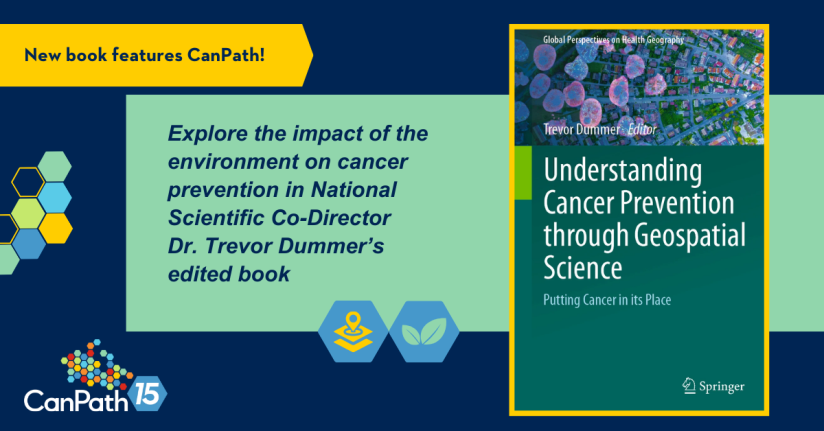Beyond the body: Dr. Trevor Dummer’s edited book untangles environmental factors influencing cancer using geospatial science

When we think of cancer’s location, we often picture it inside the human body. But a new book edited by the Canadian Partnership for Tomorrow’s Health (CanPath) National Scientific Co-Director, Dr. Trevor Dummer, disrupts this narrative and demonstrates how the environment needs to be considered to conquer cancer.
Understanding Cancer Prevention through Geospatial Science: Putting Cancer in its Place was published as part of Springer’s Global Perspectives on Health Geography Series. The volume brings together a diverse group of researchers and practitioners working in cancer prevention and other areas to share their insights.
The book details how researchers can use geospatial approaches for cancer prevention. It dives into environmental risk factors and how they shape a variety of different cancer diagnoses, including breast and bladder cancer. Most importantly, the book demonstrates through Canadian and global case studies how geospatial science can help design and drive public health solutions.
Geography’s role in the fight against cancer
Cancer is the world’s second leading cause of death, and rates of the disease continue to increase. This book tackles cancer prevention from a new angle. To understand cancer risks–and ultimately reduce cancer rates–it argues that geography must be considered and used strategically to drive prevention.
Geography—where people live, work, and play—has a profound impact on our health. Geographic information, such as neighbourhood walkability, availability of green space, or levels of air pollution, can be analyzed to assess potential relationships with cancer. This analysis can aid in creating targeted and effective cancer prevention interventions, including those focused on individuals and at the governmental and policy levels, by studying where cancer risks accumulate in local communities.
A must-read for students, researchers, practitioners, and policymakers
Designed for health researchers, public health professionals, policymakers, students and curious minds, the book has examples, tools, and techniques that bring the “where” into the “why and how” of cancer prevention. Chapter authors discuss research that illustrates new approaches to cancer control that focus on neighbourhoods, communities, and environments. The book’s chapters, organized into “Cancer, Place, Prevention,” “Geospatial Methods and Data,” and “Applications,” provide a roadmap for learning and applying new knowledge.
The CanPath connection
A chapter in the book discusses the recent data linkage between CanPath, Canada’s largest population health study, and The Canadian Urban Environmental Health Research Consortium (CANUE), which has a rich source of environmental health data.
“The unique collaboration between CanPath and CANUE allowed us to highlight in one of our chapters how large prospective cohorts are integral to better understanding the multi-faceted causes of cancer and can play a crucial role in supporting cancer prevention action,” says Dr. Dummer.
This collaboration, which connects participant’s health and demographic data with geographic exposures via postal codes, has already resulted in several published studies. Research using CanPath and CANUE data shows that traffic-related air pollution is associated with increased bladder cancer risk. At the same time, neighbourhood walkability offers protection against obesity and promotes physical activity. Studying the geospatial context of the environmental factors contributing to cancer can guide policymakers toward healthier urban planning and public health policies.
To learn more about the insights and research shared in Understanding Cancer Prevention through Geospatial Science: Putting Cancer in its Place, visit the book’s page on Springer.
Researchers are encouraged to submit a data access request through CanPath to explore the links between environment and health and how they contribute to understanding how certain factors shape health outcomes so we can advance targeted cancer prevention strategies.
Meet the editor: Dr. Trevor Dummer

Dr. Trevor Dummer is a health geographer who has conducted many studies on the built environment and cancer risk. He has a PhD in Environmental Epidemiology from Newcastle University and has been the National Scientific Co-Director of CanPath since 2018, though he has been involved with the organization since its inception in 2008.
For more information or to arrange a media interview, please contact:
Megan Fleming
Communications & Knowledge Translation Officer
Canadian Partnership for Tomorrow’s Health (CanPath)
info@canpath.ca